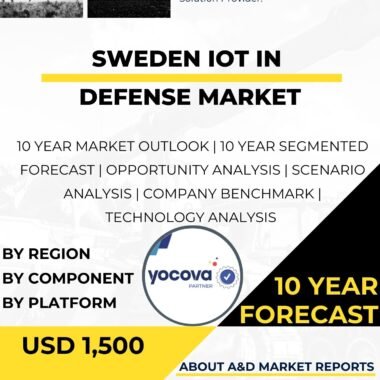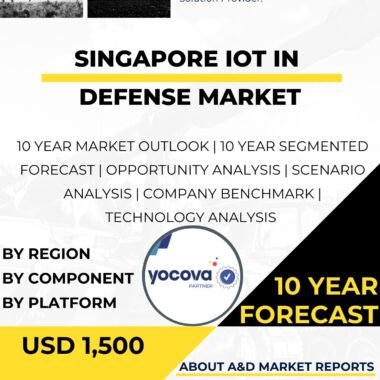Description
The Internet of Things (IoT) is a transformative technology that has found diverse applications across various industries, including defense. In Canada’s defense sector, IoT plays a crucial role in enhancing the capabilities, efficiency, and security of military operations. IoT in defense refers to the integration of connected devices, sensors, and systems that enable real-time data collection, analysis, and communication, leading to improved situational awareness, decision-making, and operational effectiveness. This integration of IoT technologies into defense systems has significant implications for Canada’s national security and preparedness in the face of evolving threats and challenges.
One of the primary applications of IoT in defense is in military equipment and platforms. Connected sensors embedded in military hardware, such as aircraft, ground vehicles, and naval vessels, enable continuous monitoring of critical systems, including engines, weapons, and avionics. Real-time data collection from these sensors provides valuable insights into the health and performance of military assets, facilitating predictive maintenance and reducing downtime. By identifying potential issues before they escalate, IoT in defense enhances the reliability and availability of military equipment, ensuring optimal operational readiness.
Moreover, IoT technologies are utilized in military logistics and supply chain management. Connected sensors and RFID (Radio-Frequency Identification) tags enable the tracking and monitoring of military assets, equipment, and supplies throughout the supply chain. This real-time visibility enhances inventory management, reduces wastage, and streamlines logistics operations, contributing to cost savings and operational efficiency.
Additionally, IoT plays a significant role in enhancing situational awareness on the battlefield. Networked sensors, cameras, and unmanned aerial vehicles (UAVs) provide real-time data and surveillance capabilities to military personnel, enabling them to assess threats, monitor enemy activities, and gain a comprehensive understanding of the operational environment. This improved situational awareness enhances the decision-making process and enables more effective responses to changing tactical situations.
The integration of IoT with artificial intelligence (AI) and machine learning further enhances defense capabilities. AI-powered analytics can process vast amounts of data from connected devices, recognize patterns, and predict potential threats or anomalies. This advanced data analysis enables more informed decision-making, enabling the military to allocate resources efficiently and respond proactively to emerging threats.
Security is a paramount concern in defense, and IoT devices are no exception. The Canadian defense industry prioritizes robust cybersecurity measures to protect IoT systems from potential cyber-attacks. Encryption, secure communication protocols, and authentication mechanisms safeguard sensitive data and ensure the integrity and confidentiality of military operations.
IoT in defense also extends to military training and simulations. Connected training devices, wearable sensors, and augmented reality (AR) technologies create realistic and immersive training scenarios for military personnel. These virtual training environments enhance skills development, prepare soldiers for complex missions, and reduce the risk associated with live training exercises.
Furthermore, IoT is utilized in border security and surveillance. Connected sensors and cameras integrated with border protection systems enable continuous monitoring and detection of unauthorized activities along Canada’s borders. This enhanced surveillance aids in preventing illegal border crossings, smuggling, and potential security threats.
IoT technologies are integral to cybersecurity operations in defense. Connected systems provide comprehensive monitoring and early detection of cyber threats, facilitating rapid response and mitigation measures. Moreover, IoT enhances the resilience of defense networks and communications, ensuring uninterrupted connectivity during critical operations.
In addition to its military applications, IoT in defense also contributes to disaster response and humanitarian missions. Connected devices and sensors assist in search and rescue operations, monitoring disaster-affected areas, and providing real-time data for effective disaster management and relief efforts.
The integration of IoT technologies fosters collaboration and interoperability with allied nations. By aligning defense systems and communication protocols, Canada can participate in joint military exercises, multinational operations, and NATO missions, enhancing regional and global security cooperation.
In conclusion, IoT technologies have emerged as a transformative force in Canada’s defense industry, providing significant enhancements in military capabilities, efficiency, and security. IoT’s integration with military equipment, logistics, and situational awareness enables real-time data collection, analysis, and communication, enhancing operational readiness and decision-making. Moreover, IoT facilitates predictive maintenance, streamlined logistics, and cost savings in defense operations. The integration of AI with IoT further optimizes data analysis and improves defense capabilities. Robust cybersecurity measures are prioritized to safeguard IoT systems and ensure data integrity and confidentiality. IoT in defense extends to military training, simulations, border security, and cybersecurity operations, contributing to Canada’s overall security and national preparedness. Moreover, IoT technologies have applications in disaster response and humanitarian missions. The interoperability of IoT systems with allied nations fosters cooperation and enhances collective defense capabilities. As technology continues to evolve, IoT will remain a critical enabler of innovation and efficiency in Canada’s defense industry, supporting the country’s mission to ensure national security and safeguard its interests.




